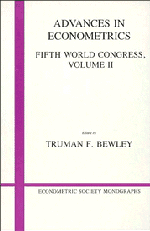Book contents
- Frontmatter
- 9 Econometric metaphors
- 10 Econometric methodology: a personal perspective
- 11 Making economics credible
- 12 The empirical analysis of tax reforms
- 13 Tests for liquidity constraints: a critical survey and some new observations
- 14 Life-cycle models of consumption: Is the evidence consistent with the theory?
- 15 A framework for relating microeconomic and macroeconomic evidence on intertemporal substitution
- 16 The short-run behaviour of labour supply
- 17 Some pitfalls in applied general equilibrium modeling
- 18 Operationalizing Walras: experience with recent applied general equilibrium tax models
14 - Life-cycle models of consumption: Is the evidence consistent with the theory?
Published online by Cambridge University Press: 05 January 2013
- Frontmatter
- 9 Econometric metaphors
- 10 Econometric methodology: a personal perspective
- 11 Making economics credible
- 12 The empirical analysis of tax reforms
- 13 Tests for liquidity constraints: a critical survey and some new observations
- 14 Life-cycle models of consumption: Is the evidence consistent with the theory?
- 15 A framework for relating microeconomic and macroeconomic evidence on intertemporal substitution
- 16 The short-run behaviour of labour supply
- 17 Some pitfalls in applied general equilibrium modeling
- 18 Operationalizing Walras: experience with recent applied general equilibrium tax models
Summary
Abstract In this chapter I discuss some empirical evidence that reflects on the validity of life-cycle models of consumer behavior. I make no attempt to provide a survey but rather focus on a number of specific issues that seem to me to be important or that seem to have been unreasonably neglected in the current literature. The chapter has three sections. The first looks at the stylized facts. In particular, I look at the nonparametric evidence with emphasis on both consumption and labor supply and the interaction between them. I present some aggregate time series data from the United States; these suggest that simple representative agent models of the life cycle are unlikely to be very helpful, at least without substantial modification. It is particularly hard to come up with one explanation that is consistent both with these data and the wealth of evidence on consumption and labor supply from microeconomic information. However, I argue that the main problem here is not so much the theory as the aggregation; except under extremely implausible assumptions, including the supposition that consumers are immortal, life-cycle theory does not predict the sort of aggregate relationships that are implied by representative agent models. In particular, it makes little sense to look for a simple relationship between the real rate of interest and the rate of growth of aggregate consumption. Section 2 is concerned with the estimation of parametric models on aggregate time series data. I review briefly the “excess-sensitivity” issue as well as some of the econometric problems associated with the nonstationarity of the income and consumption time series. My main point, however, is to argue that there are interactions between the time series representation of income and the life-cycle model that have not been adequately recognized in the literature.
- Type
- Chapter
- Information
- Advances in EconometricsFifth World Congress, pp. 121 - 148Publisher: Cambridge University PressPrint publication year: 1987
- 81
- Cited by

